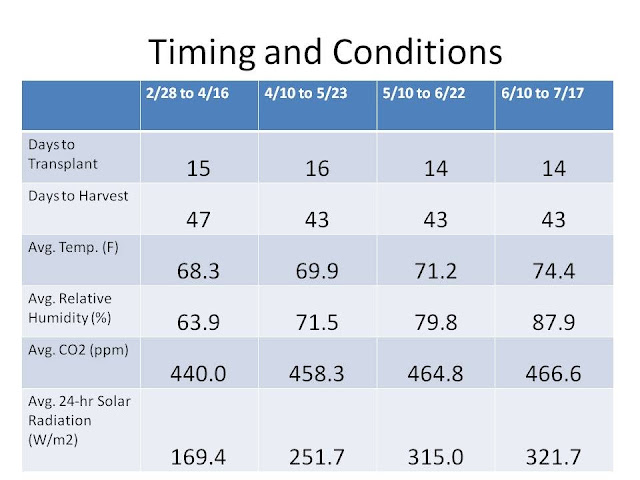Beefsteak
Cultivar Trials- Part 1 (The Pictures)
By Dr. Natalie Bumgarner
Objectives
Greenhouse tomato production in the United States now
encompasses a wide spectrum of fruit types and cultivars. Producers desire both
attractive and distinctive crop cultivars to meet consumer demand, but
consistency in both productivity and quality is still a key. Even with the
increasing desire for specialty cultivars, many small to mid-scale growers
still often establish and maintain their a large portion of their sales with
beefsteak tomatoes. For many US consumers, high visual and taste quality in beefsteak
tomatoes is the basis for greenhouse tomato price premiums. Because many
greenhouse vegetable producers rely on a few specific cultivars, the production
and reliability of those cultivars is essential. Additionally, over time their customers
become accustomed to the taste and appearance of a certain cultivar and change
must be carefully weighed. However, cultivars are sometimes discontinued or
unavailable due to seed shortages, so being familiar with other options is
quite important for growers. We generally encourage tomato growers to trial
small sections of different cultivars on a consistent basis to remain up to
date on new offerings and to be prepared if they are forced to switch
cultivars. It is obviously important for
us at CropKing to be familiar with
cultivar options for growers. So, this evaluation was carried out both to
increase our knowledge of several available beefsteaks and to provide
information for growers who may be considering these tomatoes as options for
their current crops. Cultivars were
obtained from a variety of seed suppliers to represent a broad selection of
cultivars available to greenhouse tomato producers.
Crop
Overview
• Ten
cultivars were trialed in a small block, two replicate evaluation
• Seeded
12/18
• Transplanted
1/14
• First
harvest 4/8
• Growing
point removal 11/11
• Last
harvest likely will occur between 12/15 and 12/25

Plant Management
•All ungrafted seedlings transplanted from 1.5” rockwool cubes into perlite filled Bato buckets
•Plant density was 4 ft2 per plant or 2.7 plants/m2
•Began feeding seedlings at 1.5 mS/cm EC and increased feed to 2.2-2.4 mS/cm as mature plants
•Target leach ECs were 0.3-0.6 above feed ECs (2.5 to 2.8 mS/cm)
Data Collection and Calculations
• Cluster number and harvestable fruit count at each cluster
• Plot weight and fruit counts at each harvest
• Cumulative fruit yield as well as a breakdown across the season
• Average fruit weight across the season
The images and fruit weights presented here represent an April harvest with fruit from the 1st and 2n
clusters. The November pictures were taken near the end of the crop and were generally fruit
produced on the 25th through 28th clusters.
In an upcoming blog after harvest is complete for the year, there will be a post that describes
comparative yield and fruit size throughout the season. This blog is designed to introduce the cultivars
and provide some initial visuals and fruit weights at an early and late harvest to provide a general
overview of the cultivars with more analysis and summary data planned for a later blog.
The Cultivars
Average fruit wt. these two harvest dates
 |
| BigDena-April 0.581 lb |
 |
| BigDena-November 0.502 lb |
 |
| Foronti-November 0.601 lb |
 |
| Foronti-April 0.837 |
 |
| Guyana-November 0.438 lb |
 |
| Guyana-April 0.525 lb |
 |
| Heritage-November 0.516 lb |
 |
| Heritage-April 0.566 lb |
 |
| Ladoga-November 0.562 lb |
 |
| Ladoga-April 0.601 lb |
 |
| Lola-November 0.484 lb |
 |
| Lola-April 0.513 lb |
 |
| Rapsodie-November 0.417 lb |
 |
| Rapsodie-April 0.653 lb |
 |
| BeOrange-November 0.511 lb |
 |
| BeOrange-April 0.598 lb |
 |
| Brandymaster-November 0.903 lb |
 |
| Brandymaster-April 0.910 lb |
 |
| Montenegro-November 0.431 lb |
 |
| Montenegro-April 0.535 lb |
























